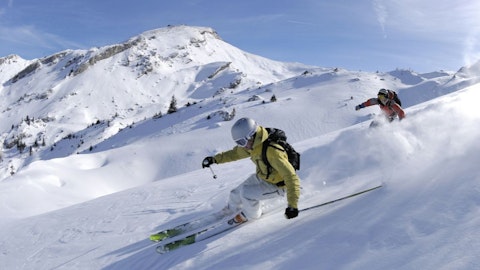Jeff Stantial: Hey, good afternoon, everyone. Thanks for taking our questions. Maybe starting off here, I wanted to drill in a bit more on some of your commentary and the headwinds that you discussed for the North America summer operations. It does seem to fit some of the narrative we’ve heard from the airlines and some other leisure businesses, but I’m curious, how do you think about this headwind and what you’re seeing over the summer as it relates to more of the upcoming ski season? And I guess what I mean by that is, is there anything that you can see in your bookings data or otherwise that sort of gives conviction that this unwinding of kind of consumer wallet share gains you saw is mostly just an off-season impact as opposed to also potentially bleeding into a ski season? Let me know if that makes sense. Thanks.
Kirsten Lynch: Yes, thank you, Jeff. We are seeing in our North America summer demand, some of that shift in summer travel behavior that you’ve heard about in the broader marketplace. And certainly, when you look at broad market data for Western mountain resorts and the lodging occupancy, it does reflect over the summer declines versus 2019. As we think about — so we do feel that our business was impacted and a part of those shifting consumer behaviors. As we look forward to winter though, I think summer and winter businesses are very different, attract very different guests. And I think the key indicator for demand to look at for this upcoming winter season is our season pass business. And our results are very strong on our season pass business with strong unit growth and strong dollar sales growth, strong renewals being the key driver of that, also incremental growth with new pass holders and seeing growth in every geography, destination, international, all of our core local geographies as well and across all product segments.
So when I look at indicators for winter, I would take our pass sales as the strongest indicator for winter versus summer which has very different guests and behavior associated with it.
Jeff Stantial: Great. That’s really helpful. Thank you. And then for my follow-up, maybe kind of adding on to some of the questions earlier but focusing more, so the cost inflation piece, that first bucket within the $46 million, I know you quantified $7 million from annualizing the employee investment that you made last year. I guess, it sounds like there’s more to that bucket than just the $7 million. So if that is the case, can you just provide some color on, I guess, what that is and, I guess, kind of why you’re, I guess, quantifying it or spelling it out? Is it something above and beyond just more kind of normal, typical wage inflation or cost inflation? Or just, could you just frame that out or provide some color on kind of what [decides] (ph) that $7 million sits within the cost inflation that you cited?
Kirsten Lynch: Hi, Jeff. Yeah, on the cost inflation there, in Q1, right, we always have inflation before the revenues, as I was mentioning. And so I think what you should think about is, you can see from inflation data that’s out there, what a normal inflation would be on our expense structure. And then for us, right, there are some investments that we always typically make in Q1 ahead of the season. And so I would point you toward the full year margin guidance of 31% where you can see how those impacts are really playing out in terms of some of the demand pieces and things we’re quantifying for Q1 specifically, but then how that is expected to kind of level out throughout the season.
Jeff Stantial: Okay, so in other words, it’s more of just a timing mismatch as opposed to kind of, say, anything structurally out of the norm. Is that fair to say?
Kirsten Lynch: Correct, and that’s something that we normally see in our Q1 ahead of winter season in North America.
Jeff Stantial: Okay, great, that’s very helpful. Thank you, both. I’ll pass it on.
Kirsten Lynch: Thank you, Jeff.
Operator: Thank you. Our next question will come from Matthew Boss with JP Morgan. Your line is open.
Unidentified Analyst: Hey, great. This is [John] (ph) on from Matt. So your resort EBITDA margin forecast for next year, it’s more or less in line with the pre-pandemic levels. Can you break down the inflation embedded on the cost side for that or any investments to build out the ancillary revenue streams this year? Like, said another way, is there any structural hurdle to margin expansion multi-year?
Kirsten Lynch: So on our margin expectations for FY ‘24, the — in FY ’22, we had some anomaly margin expansion because of the labor shortage. This year coming into FY ‘24, we’re expecting a strong margin at 31% at the midpoint. And I think, when we look at it, I think we look at winter margin looks very strong and positive. We are seeing, feeling pressure because of the Q1 assumptions that we just walked through. We see opportunities going forward in terms of resource efficiencies. And one of the key assumptions that we have in our strategies and our priorities in FY ‘24 is workforce management and rolling out workforce management across all 37 of our resorts. Beyond that also, continuing to invest in guest self-service, which creates efficiencies as well as automation.
So I feel very good about the 31% margin that we’re going to achieve and believe that there is opportunity going forward given the scale of the business, the investments that we’ve made in an integrated network that give us the opportunity to unlock some additional margin expansion in the future.
Unidentified Analyst: Great, thank you.
Operator: Thank you. Next, we have a question from Patrick Scholes with Truist. Your line is open.
Patrick Scholes: Good afternoon.
Kirsten Lynch: Hi, Patrick.
Patrick Scholes: I’m sort of beating this one-two guide to death here, but is it fair to say that $40 million to $46 million, one-third of that was just weakness in Australia around $15 million, just trying to get some better granularity on that one? Thank you.





